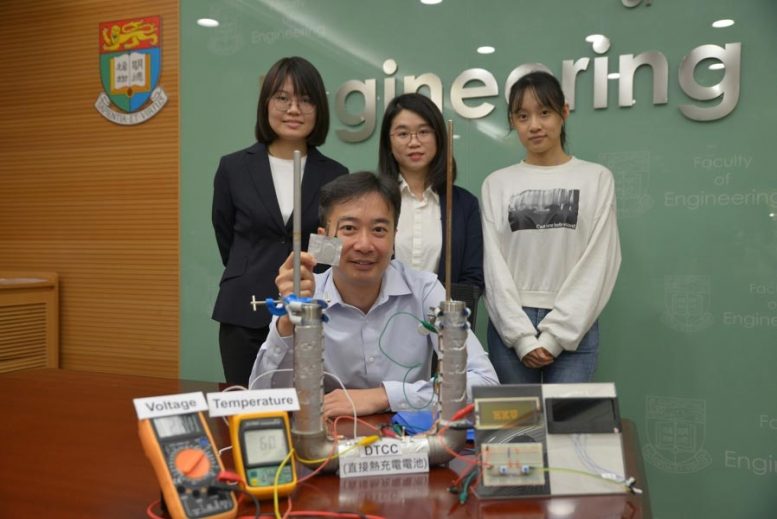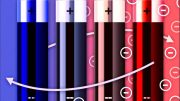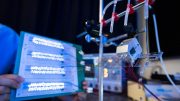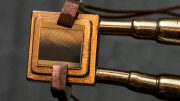
Dr. Tony Shien-Ping Feng of the Department of Mechanical Engineering at the University of Hong Kong (HKU) and his team (from left to right: Wang Xun, Huang Yu-ting and Mu Kai-yu), invented the Direct Thermal Charging Cell (DTCC), which can convert low-grade heat to electricity.
Dr. Tony Shien-Ping Feng of the Department of Mechanical Engineering at the University of Hong Kong (HKU) and his team invented a Direct Thermal Charging Cell (DTCC) which can effectively convert heat to electricity, creating a huge potential to reduce greenhouse effects by capturing exhaust heat and cutting down primary energy wastage.
The new invention is recently published in the prestigious journal Nature Communications, and the research has been featured in the Nature Communications Editors’ Highlights webpage. HKU’s Technology Transfer Office has filed for the invention’s US provisional patent and PCT (Patent Cooperation Treaty) patent.
Low-grade heat is abundantly available in industrial processes (80 to 150°C or 176 to 302°F), as well as in the environment, living things, solar-thermal (50 to 60°C or 122 to 140°F) and geothermal energy. Over 60% of the world’s primary energy input, whether it is in the industrial process or domestic energy consumption, is wasted as heat. A majority of this loss as waste heat is regarded as low-grade heat.
Video Demonstration: DTCCs connected with waste water pipes can be converted to low-grade heat and used to power OLED and smart window.
The newly designed DTCC is a game-changing electrochemical technology that can open new horizons for applications to convert low-grade heat to electricity efficiently. It is a simple system with the basic unit sized only 1.5 sq.cm and thickness 1 to 1.5 mm. The cell is bendable, stackable, and low cost.
DTCC can be used in HVAC (heating, ventilation, and air conditioning) systems to recycle low-grade heat from the compressor and condenser into electricity for use in electrical devices. It can be integrated with the window frame to harvest solar thermal energy to power electrochromic windows, or used as portable devices to power iPhones or life-saving equipment in the wilderness. With the increasing popularity of wearable technology, this system may one day harness body heat to power wearable electronic devices or medical devices for monitoring body health conditions like blood sugar levels and blood pressure.
Video Demonstration: DTCC can harness body heat to power wearable electronic devices or medical devices for monitoring body health conditions.
Dr. Feng said: “Efficient low-grade heat recovery can help to reduce greenhouse gas emission but current technologies to convert this heat to electricity is still far from optimum. DTCC yields a conversion efficiency of over 3.5%, surpassing all existing thermo-electrochemical and thermo-electric systems, which is either too costly or complicated, or too low in efficiency for everyday applications. DTCC is a revolutionary design with great potentials in smart and sustainable energy devices.”
The new thermal charging cell uses asymmetric electrodes: a graphene oxide/platinum (GO/Pt) cathode and a polyaniline (PANI) anode in Fe2+/Fe3+ redox electrolyte via isothermal heating operation without building thermal gradient or thermal cycle. When heated, the cell generates voltage via a thermo-pseudocapacitive effect of GO and then discharges continuously by oxidizing the PANI anode and reducing Fe3+ to Fe2+ under isothermal heating on cathode side till Fe3+ depletion. The energy conversion works continuously under isothermal heating during the entire charge and discharge process. The system can be self-regenerated when cooled down. This synergistic chemical regeneration mechanism allows the device cyclability.
The team is selected as one of the 16 finalists out of 300 applications and one of the only two finalists in Hong Kong competing in the Hello Tomorrow Regional Summit 2019, a competition for start-ups to adapt their research for real-world commercial uses, which took place in Singapore on Thursday, November 7, 2019.
The invention has won the Championship in the HKU 2018 DreamCatchers 100K Entrepreneurship Competition. The team has established a start-up company, High Performance Solution, which is aided by the Technology Start-up Support Scheme for Universities (TSSSU). The company also joined the Incu-Tech 3-year program at the Hong Kong Science Park and received its first revenue from the prototypes. The team has participated in the first X-plan roadshow of Talent Development Forum in Great Bay Area held by the Hong Kong X Foundation. It has also taken part at the Entrepreneurship Forum in Bahrain, Middle East.
Reference: “Direct thermal charging cell for converting low-grade heat to electricity” by Xun Wang, Yu-Ting Huang, Chang Liu, Kaiyu Mu, Ka Ho Li, Sijia Wang, Yuan Yang, Lei Wang, Chia-Hung Su and Shien-Ping Feng, 12 September 2019, Nature Communications.
DOI: 10.1038/s41467-019-12144-2
PDF









Be the first to comment on "Direct Thermal Charging Cell Converts Waste Heat Into Usable Electricity"